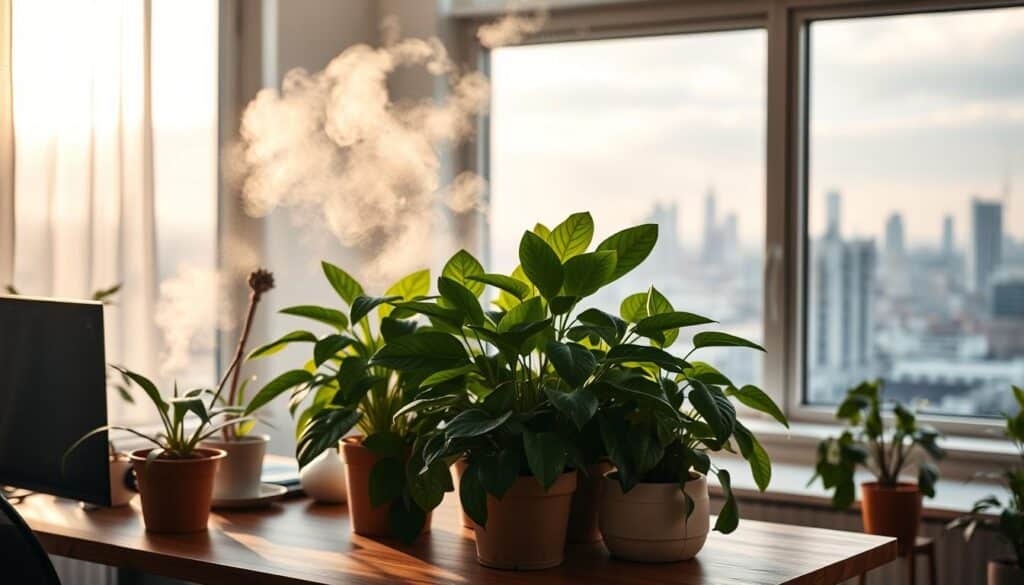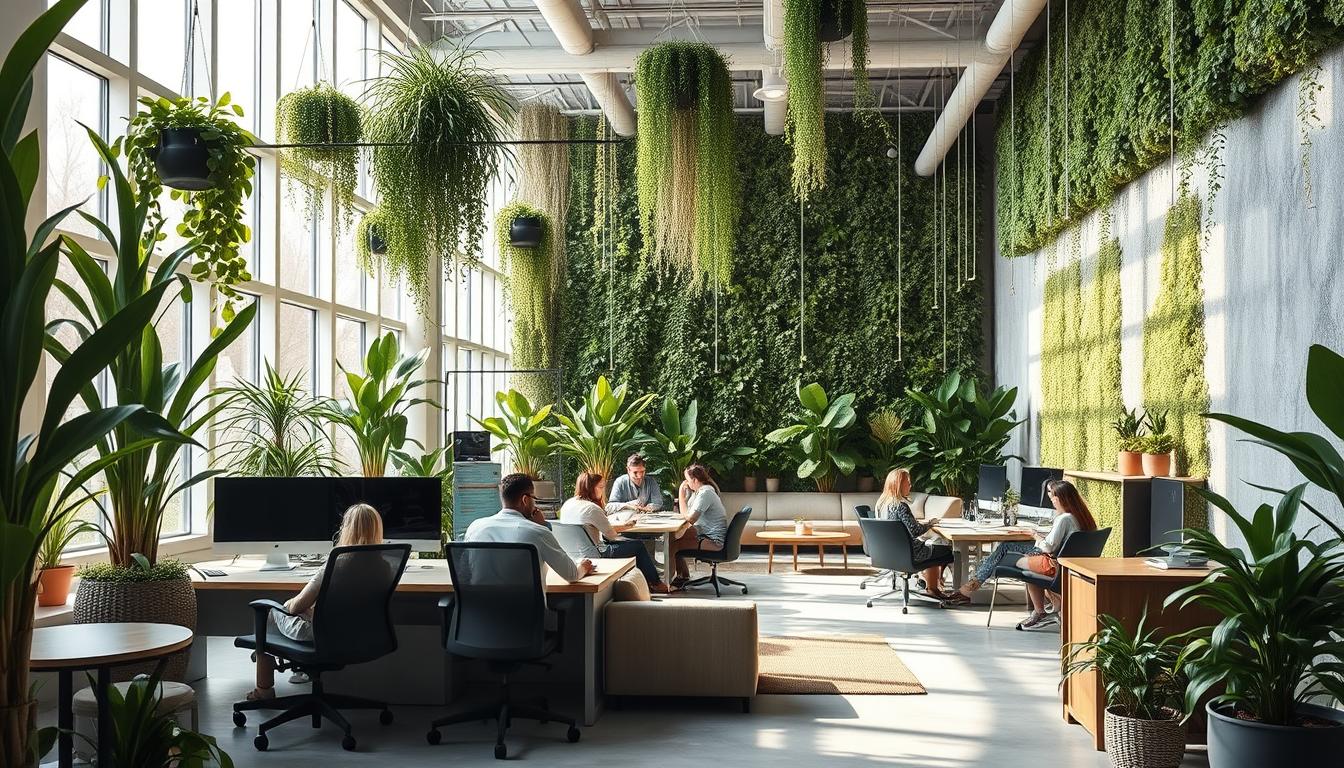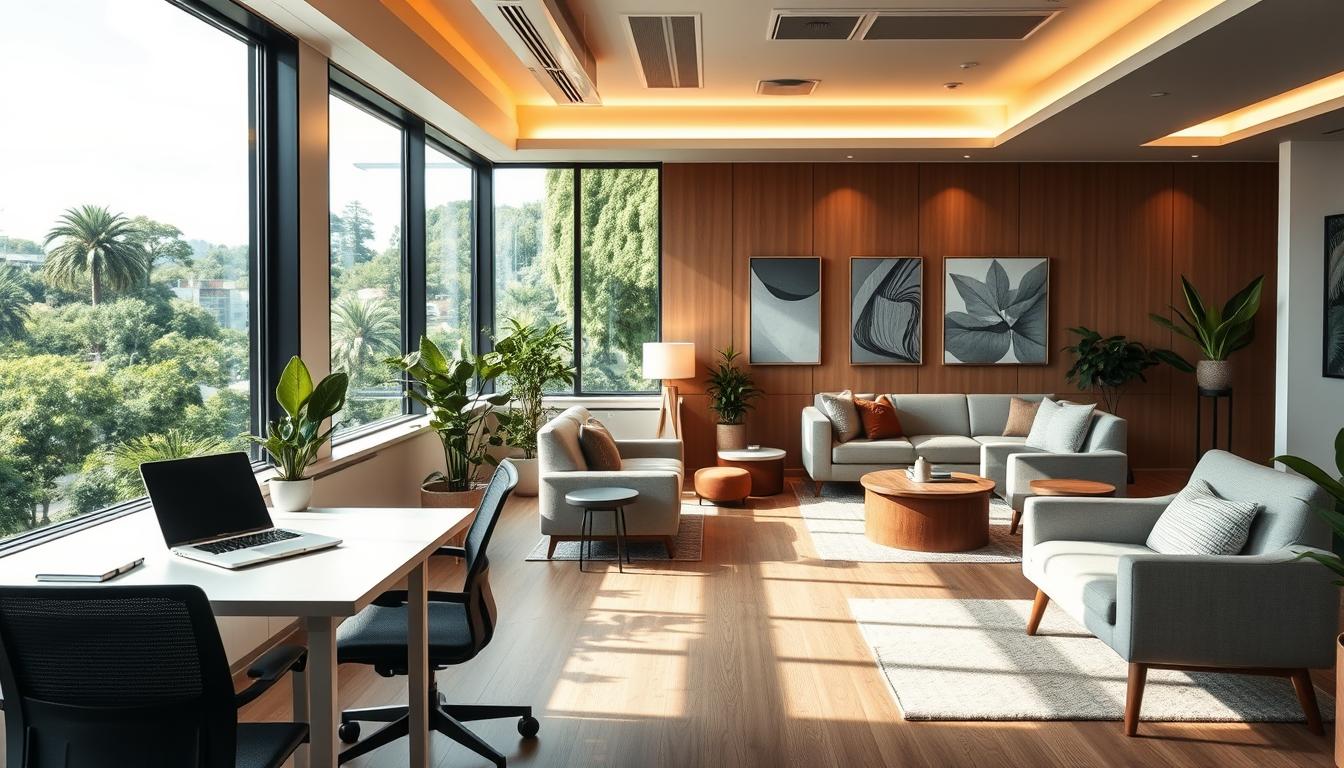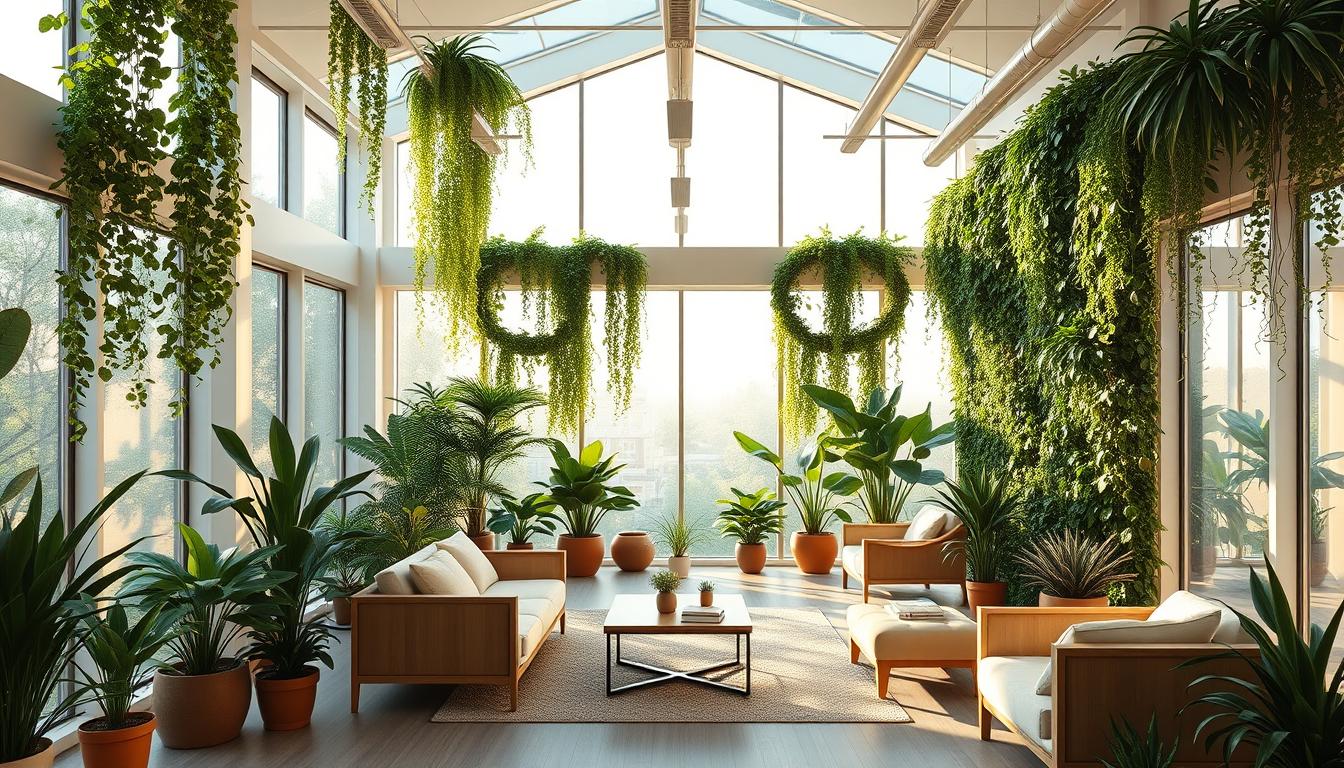Today’s fast work environments need great conditions for plants and worker productivity. Adding office plants is a smart move for humidity control. This makes your workspace look better and helps manage humidity.
Right humidity lets plants grow well. It also makes the air better and the office more comfortable for everyone.
Understanding Humidity and Its Importance for Office Plants
Humidity is about the moisture in the air. It’s very important for office plants to stay healthy. Knowing about humidity helps make indoors great for plants. Most plants do best when the air is 40-60% moist. Not enough moisture in the air can harm plants. So, managing humidity is a key part of taking care of office plants.
Some plants come from places with a lot of air moisture. They need more humidity to grow well. If the air gets too dry, these plants might not be able to get enough water. This can make their leaves turn brown or wilt. Keeping the humidity right helps plants stay strong and grow.

Impacts of Low Humidity on Indoor Plants
Low humidity can really hurt indoor plants. The browning of leaf edges is a big sign of this problem. It shows plants are drying out. When they can’t keep water, they get sick and show plant stress symptoms.
Some plants’ leaves may turn yellow or crispy. This means they are not doing well. Not enough moisture causes these indoor plant health issues. Plus, plants in dry air might not grow well and get sick more easily.
The situation gets worse with dry heating and too much air moving around, especially in offices. If you spot the signs of plant distress early, you can keep your indoor plants happy.
Finding the Ideal Humidity Levels for Office Environments
Making a great space for office plants means knowing the best humidity levels. Different plants have their own needs that affect their health and growth. For example, tropical plants do best with humidity between 50-70%. This helps them soak up moisture well and stay stress-free.
On the other hand, temperate plants like humidity a bit lower, around 40-60%. Setting your office’s humidity to match these guidelines helps all kinds of plants stay healthy. It’s especially important when the seasons change. That’s because indoor air quality can make humidity levels change a lot.
It’s key to know what your plants need in your office. By keeping an eye on and adjusting humidity for your plants, they’ll likely grow stronger and healthier. Good humidity management makes your office more welcoming. It also makes it look better and improves the air.
Choosing the Right Plants for Humidity Optimization
Choosing the right plants is key to better humidity in an office. The top plants for this task don’t just clean the air. They also make the office look better. Some plants are just better at giving off moisture, which helps with humidity.
Here are some good plants for your office:
- Peace Lilies: These plants love humid spots and boost moisture well.
- Ferns: Plants like the Boston fern keep humidity well and grow best in bright areas.
- Spider Plants: They have long leaves that add to the room’s look and help keep moisture in the air.
Big-leaf plants, like rubber trees and monstera, are also great for moisture. When picking plants for offices, make sure they fit the office’s light and feel. Choosing wisely can make your workspace healthier and nicer to be in.
Humidity Control Using Office Plants: Effective Techniques
Using the right techniques can greatly improve office plants’ health. Adding plants makes the office look better and improves the air. Two key methods, grouping plants and using pebble trays, help raise humidity.
Grouping Plants Together for a Microclimate
Putting plants together helps create a microclimate that’s good for humidity. When plants are close, they give off moisture. This helps all the plants nearby by making the air more humid. This is really helpful in big offices where the air can feel dry.
Using Pebble Trays to Increase Local Humidity
Pebble trays are another great way to keep plants happy. You fill a shallow tray with pebbles and water and put it under the plants. As the water evaporates, it makes the air around the plants more humid. It’s an easy way to help plants without watering them too much.
Utilizing Humidifiers for Enhanced Plant Health
Humidifiers are key to keeping humidity levels perfect for indoor plants, especially in offices where air gets too dry. By using a humidifier, you help indoor plants grow better in a good environment.
Selecting the Appropriate Humidifier for Your Space
Choosing the right humidifier is important. You need to think about the size of the room, how many plants you have, and how quiet you want it to be. Bigger humidifiers are great for large areas, and smaller ones are best for tight spaces. When picking a humidifier, remember to:
- Room Size: Match the humidifier capacity to the square footage of your office.
- Noise Level: For a quiet work environment, look for options designed to operate silently.
- Type of Humidifier: Choose between cool-mist and warm-mist options based on your specific needs.
Maintaining Optimal Moisture Levels with Technology
Modern humidifiers with sensors are awesome. They change how much mist they put out to keep moisture steady. This stable moisture is key for indoor plant health. With controlled humidity, your plants will avoid the problems that come with too little humidity.
Signs Your Plants Need More Humidity
Knowing when your plants need more humidity is key to keeping them healthy. Office spaces often have air that’s too dry. Spotting the signs early can save your plants and help them grow better.
Identifying Symptoms of Low Humidity in Office Plants
Your office plants might show they’re not getting enough humidity. Look for these signs:
- Wilting leaves, which may appear limp or droopy
- Browning edges, where leaf tips become dry and crispy
- Crispy leaves that have lost their vibrancy and structure
These symptoms tell you the air might be too dry for plants to grow well.
Understanding Plant Responses to Environmental Stress
Plants react in different ways when they’re not happy with the humidity. Knowing these signs helps you care for them properly. Look out for:
- Increased leaf drop as the plant conserves moisture
- Stunted growth as the plant struggles to thrive
- Unusual leaf patterns or discoloration signaling distress
Noticing these reactions allows you to take steps to improve the air around your plants. This helps them live longer and stay healthy.
Additional Methods to Boost Humidity in the Office
Looking into various ways to increase humidity can really help your office’s air moisture. Simple steps can greatly help your plants feel better, especially when it’s dry. By raising humidity, you’re not just helping your plants. You’re also making the workspace nicer for people.
Using Spray Bottles and Misting Techniques
Misting plants with water is a good way to up the humidity around them. You use a spray bottle to wet the leaves and air nearby. This gives a quick moisture boost. But be careful with plants that have fuzzy leaves. Too much water can make them sick. Adding this tip to your plant care routine can lead to good things.
Relocating Plants to More Humid Areas
Moving your plants to rooms like the kitchen or bathroom can help them a lot. These spots tend to have more moisture, which is great for the plants. Using these natural humidity spots means your plants stay moist, even when it’s dry.
Conclusion
In summary, controlling humidity is key for indoor plants’ health, especially in offices. By using the tips in this article, you can take better care of your office plants. Keeping the right humidity levels is crucial for the plants’ look and health.
Also, a humid environment is good for both plants and people. It makes the workplace air better and more comfortable. This summary tells us that small changes can make a big difference in plant health and the office vibe.
These easy methods help grow a thriving indoor garden. With careful humidity control, everyone in the office will enjoy lively greenery. This boosts work satisfaction and productivity.



